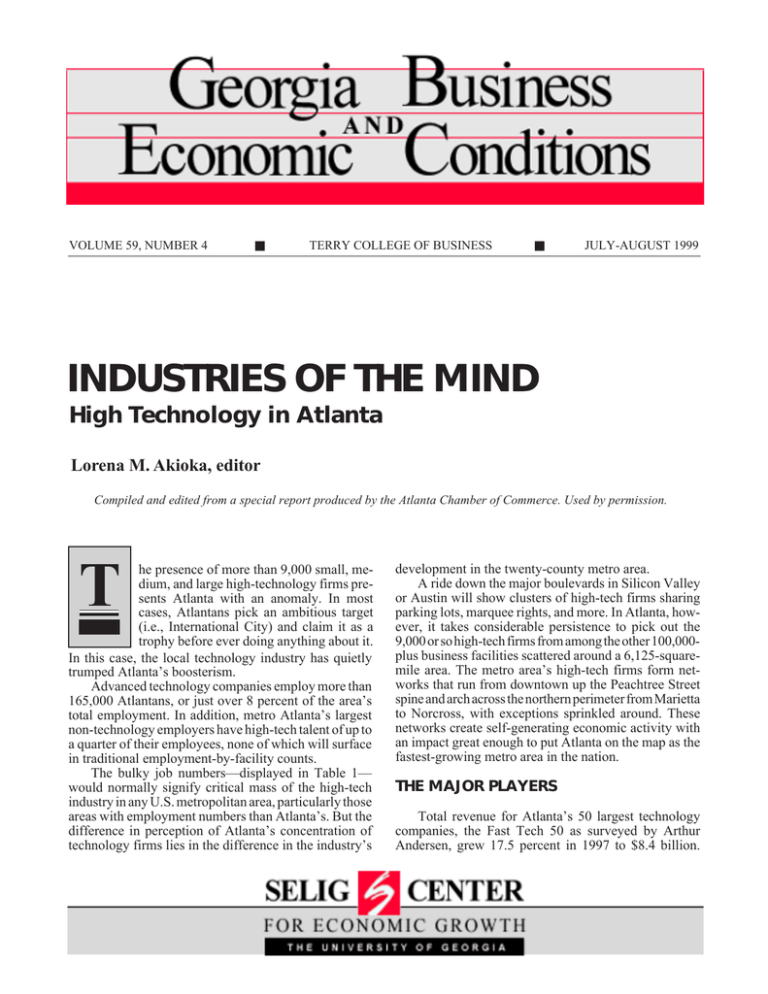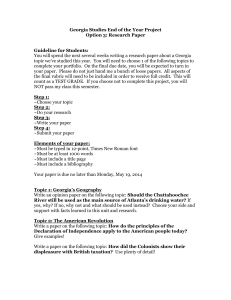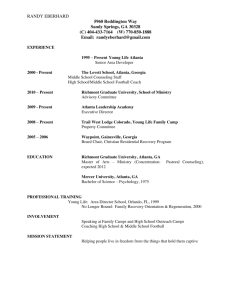Document 10972219
advertisement

VOLUME 59, NUMBER 4 ■ TERRY COLLEGE OF BUSINESS ■ JULY-AUGUST 1999 INDUSTRIES OF THE MIND High Technology in Atlanta Lorena M. Akioka, editor Compiled and edited from a special report produced by the Atlanta Chamber of Commerce. Used by permission. T he presence of more than 9,000 small, medium, and large high-technology firms presents Atlanta with an anomaly. In most cases, Atlantans pick an ambitious target (i.e., International City) and claim it as a trophy before ever doing anything about it. In this case, the local technology industry has quietly trumped Atlanta’s boosterism. Advanced technology companies employ more than 165,000 Atlantans, or just over 8 percent of the area’s total employment. In addition, metro Atlanta’s largest non-technology employers have high-tech talent of up to a quarter of their employees, none of which will surface in traditional employment-by-facility counts. The bulky job numbers—displayed in Table 1— would normally signify critical mass of the high-tech industry in any U.S. metropolitan area, particularly those areas with employment numbers than Atlanta’s. But the difference in perception of Atlanta’s concentration of technology firms lies in the difference in the industry’s development in the twenty-county metro area. A ride down the major boulevards in Silicon Valley or Austin will show clusters of high-tech firms sharing parking lots, marquee rights, and more. In Atlanta, however, it takes considerable persistence to pick out the 9,000 or so high-tech firms from among the other 100,000plus business facilities scattered around a 6,125-squaremile area. The metro area’s high-tech firms form networks that run from downtown up the Peachtree Street spine and arch across the northern perimeter from Marietta to Norcross, with exceptions sprinkled around. These networks create self-generating economic activity with an impact great enough to put Atlanta on the map as the fastest-growing metro area in the nation. THE MAJOR PLAYERS Total revenue for Atlanta’s 50 largest technology companies, the Fast Tech 50 as surveyed by Arthur Andersen, grew 17.5 percent in 1997 to $8.4 billion. 2 TABLE 1 High-Technology Facilities and Employment in Metro Atlanta Industry Description Biomedicine and Biotechnology Computer Cabling Computer Software, Programming and Services Computers and Office Equipment Manufacturing Electronic Equipment Manufacturing Engineering, R&D and Related Services Instruments & Apparatus Manufacturing Telecommunications Services TOTAL Facilities 41 1,341 3,893 38 169 2,778 97 842 9,199 Employment 7,303 14,061 49,699 2,498 13,833 25,952 3,086 49,748 166,180 Source: Georgia Department of Labor, 1998 GEORGIA BUSINESS AND ECONOMIC CONDITIONS July-August 1999 Volume 59, number 4 SELIG CENTER FOR ECONOMIC GROWTH P. George Benson Dean Lorena M. Akioka Editor Beata D. Kochut Research Coordinator Jeffrey M. Humphreys Director Economic Forecasting vacant Data Collection Coordinator GEORGIA BUSINESS AND ECONOMIC CONDITIONS (ISSN 0297-3857) is published bimonthly by the Simon S. Selig, Jr. Center for Economic Growth, Terry College of Business, The University of Georgia, as a service to the business and academic communities. Signed articles reflect the author’s opinion but not necessarily those of the Selig Center for Economic Growth, Terry College of Business , or The University of Georgia. This publication is sent free of charge upon request. Manuscripts and letters to the Editor should be sent directly to us. Postmaster send address changes to: Selig Center for Economic Growth, Terry College of Business, The University of Georgia, Athens, GA 30602-6269. Periodicals postage paid at Athens, Georgia These firms showed evidence of an increase in venture capital and more public technology companies that are rising to the top. In addition, other Atlanta-based companies are recognized for the impact they make in specific industries. For example, Electronic Business lists HBO & Co. and Scientific-Atlanta in its rankings of the 200 largest U.S.-based electronics companies. A quarter of the 29 Fortune 1,000 firms headquartered here (Tables 2 and 3) do their primary business in high-tech areas ranging from advanced information technology to Web content, including: Cox Communications, BellSouth, Equifax, HBO & Co., Scientific-Atlanta, and two with dual headquarters: First Data and Vanstar. Mindspring is an Internet service provider with global recognition. Another little-known fact is that Atlanta is home to Lucent Technologies’ second-largest operation outside of its headquarters. Others—such as SQL Financials—slip quietly into national recognition. More recently, a dozen Atlanta technology companies cracked Inc. 500’s rankings of the nation’s fastestgrowing private firms, including Tactics, Clarus, T/R Systems, Patient Care Technologies, Wakefield Pharmaceuticals, Management Decisions, Capricorn Systems, Network One, Matrix Resources, Ashford International, US Energy, and Witness Systems. INVESTMENT BY INTERNATIONAL FIRMS International high-tech firms have staked out a major presence in metro Atlanta and are more than a quarter of the 1,200 international businesses here. Major international manufacturers—Siemens, Philips, Mitsubishi— have opened new operations in the last year and are Georgia Business and Economic Conditions 3 TABLE 2 Atlanta’s Largest Technology Headquarters by Revenues Company BellSouth Corp. First Data* Turner Broadcasting System Vanstar* Philips Consumer Electronics Equifax Cox Communications HBO & Co. (McKesson) Scientific-Atlanta Medaphis Corp. National Data Corp. LeyLink Dickens Data Systems Nova Information Systems Premiere Technologies Hayes Corp. CheckFree Corp. Electromagnetic Sciences 1997 Revenues (millions) Companywide Employees $20,561.0 5,235.0 3,437.4 2,179.0 2,000.0 1,706.0 1,610.0 1,203.2 1,170.0 572.6 433.8 347.7 336.0 229.4 199.6 176.4 171.2 81,000 36,000 6,000 6,000 10,000 10,000 7,725 6,286 5,800 9,800 2,900 420 600 1,700 600 1,444 1,200 * Dual Headquarters Source: Arthur Andersen LLP; Atlanta Business Chronicle ; Fortune, “The Fortune 1,000” expanding their presence here. Robert Minkhorst, president and CEO of Philips Consumer Electronics North America’s headquarters, said his company chose Atlanta because “the city offers a wealth of skilled labor, and has excellent engineering schools, in addition to a progressive and supportive business community.” In the first half of 1998, half of the 20 new international businesses that relocated to metro Atlanta were high-tech firms. Siemens relocated two divisions, Electromechanical Components and Electronics Assembly, and Mitsubishi brought in a fiber manufacturing division. Card Guard USA joined the more than dozen or so other high-tech firms from Israel that are building a major presence here. TECHNOLOGY IN OTHER MAJOR COMPANIES An examination of the largest Atlanta employers in industries outside the technology arena shows that most do employ some high-tech specialists, mainly in information systems management (see accompanying box on page 5). A quarter of these companies report that more than 20 percent of their employees are high-tech. The remaining companies report an average of 4 percent technical employment. July-August 1999 The Home Depot reported the highest percentage, counting two-thirds of its employees as technical specialists. The remaining firms with higher percentages included financial companies, utilities, the Coca-Cola Company, and Georgia-Pacific. On average, a quarter of the employees in each of these corporations are classified as high-tech specialists. MOVING IN Last year, the American Electronics Association cited Georgia as the national leader in high-tech job growth, and metro Atlanta supports more than threequarters of this growth. Feeding it are Atlanta’s welleducated workforce, a heavy in-migration of the nation’s best talent, and state-of-the art educational and training programs that supply a steady stream of graduates. By some recent measures, the 60,000 graduates who have flocked here make Atlanta the leading destination for college graduates. According to the U.S. Census Bureau, the metro area ranks second only to Boston in the percentage of its people aged 25 and over with a college degree. The area’s more than 40 universities, colleges, and technical schools also feed this growth, sending 30,000 new degree-holders into the job market each year. 4 TABLE 3 Atlanta’s Top 25 High-Tech Employers (ranked by number of employees in Atlanta) Company BellSouth Corp. AT&T Lockheed Martin Lucent Technologies IBM Corporation Turner Broadcasting System Cox Communications MCI/Worldcom Scientific-Atlanta Equifax First Data Corp. Worldspan L.P. Hewlett-Packard Nortel Networks Electronic Data Systems (EDS) NCR Corp. Alltel Sprint HBO & Co. (McKesson) National Data Corp. Compaq Computer Corp. Electomagnetic Sciences Federated Systems Group Scientific Games International Lanier Worldwide Metro Atlanta Employees 1997 Companywide Revenues (millions) 17,080 11,200 9,200 7,300 6,235 4,783 4,198 4,000 3,200 2,780 2,090 1,800 1,700 1,700 1,600 1,550 1,200 1,200 1,073 1,063 1,000 1,000 850 800 767 $20,561 53,261 28,069 26,000 78,500 3,437 1,610 19,653 1,168 1,400 5,200 575 42,900 15,500 15,235 6,589 3,264 14,874 1,203 525 24,584 171 NA 197 1,256 Source: Atlanta Business Chronicle; Fortune, “The Fortune 1,000” RESOURCES Essential to any region that considers itself a member of the National Silicon League is a concentration of R&D activity and centers, technology incubators, and the active participation of funding partners, or venture capital. Add to this list metro Atlanta’s active, wellpopulated industry associations that support these efforts, and Atlanta’s technology players are in the game. R&D Research and development expenditures have risen steadily in Georgia in the last several years. The Georgia Research Alliance, a public/private partnership of major businesses with local research universities, is due much credit for helping to funnel national attention and funding support into the state’s R&D institutions. Joining the set of highly regarded research facilities affiliated with the area’s major science and technical institutions, a number of new research facilities were announced in 1998. Lucent Technologies and Motorola unveiled plans to put a new chip design center in Atlanta as part of their alliance to develop digital signal processor technology. Intel spearheaded a group of semiconductor companies in talks with Georgia Tech (one of six chosen campuses), about founding a $10 million-a-year center to find ways for radically improving chip performance. Georgia Tech also received $12.5 million from the National Science Foundation to establish a national research center for tissue engineering. Tech was one of only five institutions selected to receive a five-year NSF grant for engineering technology. In August 1988, announcement was made about a new 42-acre, $31 million biotech center, to be built three miles from downtown Atlanta. This biomed-bioengineering research facility and incubator—a joint venture between Emory University and Georgia Tech—is expected to support 24 research companies and create 12,000 new jobs within the next ten years. Georgia Business and Economic Conditions 5 HIGH-TECH JOBS WITHIN SOME OF METRO ATLANTA’S LARGEST EMPLOYERS Company Atlanta Board of Education Atlanta Gas Light City of Atlanta Clayton County Public Schools Cobb County Government Cobb County School District Coca-Cola Co., The Columbia HCA/Georgia Division DeKalb County Govenrment Delta Air Lines (Delta Technology) Equifax (includes FBS Software) Fulton County Board of Education General Motors Corp. Georgia Institute of Technology Georgia State University Georgia-Pacific Corp. Gwinnett Public Schools Home Depot, The NationsBank (Bank of America) Rich’s/Lazarus/GoldSmith’s Southern Co., The State of Georgia U.S. Centers for Disease Control & Prevention United Parcel Service Estimated High-Tech Employment in Atlanta 125 115 250 38 75 120 1,050 35 138 2,220 (Nationwide) 700 98 70 Over 1,000 491 850 - 900 60 800 1,700 10/300 - Federated 1,400 140 800 219 Percent of Total Atlanta Employment 1.6 5.8 3.1 0.7 2.1 1.3 21.0 0.6 2.5 8.7 23.0 1.4 1.3 27.2 18.2 20.5 0.6 66.6 24.4 0.2 26.9 1.8 20.0 3.9 Source: Metro Atlanta Chamber of Commerce phone survey, 9/98 ■ July-August 1999 ■ 6 deals have happened here since 1995, according to Pricewaterhouse-Coopers. In that same time, Atlanta’s share has grown faster than that of five other recognized technology corridors—Silicon Valley, Boston, Denver/ Boulder, Austin, and the Research Triangle. Communications and software/information firms attract the greatest amount of venture investments. From 1995 through the second quarter of 1998, they brought $140.7 million and $244.6 million, respectively, into Georgia. Some of the larger, more recent deals include: ■ $30 million for iXL, a multimedia and Internet services firm. ■ $23 million for Greenberg News Networks, an Internet information channel for physicians. ■ $11.5 million for Microwave Instrumentation Technologies, LLC, a microwave applications design firm. ■ $10 million for Lynk Systems, a provider of transaction processing. Technology Business Incubators The joint EmoryGeorgia Tech biotech venutre will be the newest of more than a dozen business incubators in Georgia, more than half of them in metro Atlanta. The grandfather of local technology incubators is the Advanced Technology Development Center, a statefunded enterprise which opened at Georgia Tech in 1980. By 1997, ATDC’s 88 member and graduate companies had generated more than $300 million in revenues and employed nearly 2,500 people. Mindspring and Theragenics are two of its better-known graduates. Two other local incubators help foster the growth of high-tech entrepreneurial businesses. The Intelligent Systems Shared Resource Technology Center, a private facility founded in 1990 in Norcross, nutures up to 22 companies at a time. ChemFree, Peachtree Software, and Digital Wireless are among its successes. The Fulton County Business Incubator is newer, founded in 1997 and funded by Fulton County. Its firms are in the telecommunications and information technology industries, and it is currently seeding the growth of a half-dozen companies. Venture Capital Metro Atlanta is the clear favorite for venture capital investment in the Southeast (see Tables 4 and 5). More than $413 million in technology INFRASTRUCTURE ADVANTAGES Local companies in telecommunications services, equipment manufacturing, news and entertainment production, and software development are creating in metro Atlanta the world’s leading telecommunications center. METRO ATLANTA’S TOP VENTURE CAPITAL FIRMS Firm Cravey, Green & Wahlen Noro-Moseley Partners Arete Ventures Cordova Capital River Capital EGL Holdings Equity South Advisors LLC Richards Capital under Management (millions) $378 214 155 133 54 50 41 30 Industry Preferences health care, manufacturing technology, medical telecom, software, info systems telecom, info technology, health care light manufacturing manufacturing, health care software, manufacturing light manufacturing Source: Atlanta Business Chronicle, Jan. 30, 1998 Georgia Business and Economic Conditions 7 TABLE 4 Venture Capital Investment Growth - Investment in Technology Companies ($ millions) Metro Area 1995 1996 1997 Atlanta, GA Austin, TX Research Triangle Park, NC Denver-Boulder 97.2 50.1 47.0 31.2 44.7 80.4 54.7 161.1 180.3 145.3 83.6 160.9 1st Qtr. 1998 52.9 25.3 39.1 64.6 Source: PricewaterhouseCoopers LLP, courtesy The Atlanta Journal and Constitution Atlanta-based companies lead this industry’s developments in service, R&D, and manufacturing. For example, BellSouth provides here the world’s largest toll-free calling area, at 7,164 square miles and more than two million access lines. The local dialing area also provides the latest in ISDN technologies. Nearly a half-million miles of fiber-optic cable crisscross the state and Atlanta has the greatest number of videoconferencing sites in the world. OTHER SUPPORT Like any healthy technology community, metro Atlanta boasts a vibrant network of private technology associations and public groups whose sole aim is to foster the growth of local opportunities. Founded this year, The Technology Association of Georgia (TAG) is an alliance of three of the most influential local high-tech associations: Business and Technology Alliance, which promotes and develops an infrastructure in Georgia that encourages and facilitates technology transfers; Southeastern Software Association, which promotes the Southeast’s software industry; and Women in Technology, which allows women in the Atlanta technology community a forum for education, professional growth, interpersonal and business relationships, and community service. TAG serves as an umbrella group for all technology associations, strengthening the associations and successes of all firms doing business throughout the state. Some other prominent associations include the Interactive Media TABLE 5 Georgia Venture Capital Investments by Industry ($ thousands) Industry Software & Information Medical Instruments & Devices Computers & Peripherals Biotechnology Communications Electronics & Instrumentation 1995 1996 35,250 1,500 1,200 — 34,666 — 89,988 — 7,552 9,500 17,177 — 1997 87,397 6,155 3,500 725 60,866 13,000 1st Qtr. 1998 14,125 — — 1,350 28,000 — Source: PricewaterhouseCoopers LLP Money Tree Survey, courtesy Atlanta Business Chronicle July-August 1999 2nd Qtr. 1998 17,850 10,475 3,000 — — — 8 Alliance, American Electronics Association, Association of Internet Professionals, Atlanta Venture Forum, Georgia Biomedical Partnership, and the Technology Executives Roundtable. rose to over $700 million in 1997. The GRA’s objective is to see this investment raised to $1.2 billion by the year 2000. The Georgia Center for Advanced Telecommunications Technology is an academic-business-government partnership formed in 1991. It was designed to help PUBLIC SUPPORT increase research funding, to design advanced telecommunications networks for the state, and to serve small-toThe state itself has spearheaded the development of midsized information companies with news of and applilocal high-tech industries with major investments and support. In the forecations for new front of these efforts technologies. Its is the Georgia Reflagship building search Alliance, opened in 1996 to FOR MORE INFORMATION which has brought house the program’s the state together eminent scholars, with private busilabs, classrooms This article describes only a part of metro Atlanta’s ness to develop farand exhibit space. decade-long transformation into a high-tech hub. For further reaching initiatives. GRA’s Emiinformation, and a more complete listing of the high-technolIn less than a denent Scholars proogy firms in the area, visit the Metro Atlanta Chamber of cade, the GRA has gram was develCommerce website at www.metroatlantachamber.com and pumped up the oped to help expand look in the “Industries of the Mind” section. R&D investments the state’s knowllevel in Georgia, edge base. To date, opened a preemi29 of the eminent nent center for inresearch scholars formation and adfrom throughout the vanced telecommunications technology R&D, and is world have moved to Georgia’s research universities to building a long-range industry advantage with its Emifill endowed chairs supplied with the latest, state-of-thenent Scholars Program. art equipment and new lab facilities. The most recent In 1990, the year the GRA was formed, Georgia arrival is scientist Steven Stice, who, in addition to universities were conducting $400 million in sponsored holding a new $1.5 million endowed chair at the Univerresearch annually. Since the GRA has been investing in sity of Georgia, is developing a new company to clone the research infrastructure, the annual university R&D cattle and pigs. ■ FOR MORE INFORMATION Georgia Business and Economic Conditions 9 CONNECTING WITH THE WORLD: GEORGIA ENTERS THE THIRD MILLENNIUM Suzanne A. Lindsay he arrival of the Third Millennium A.D. is a momentous turning point. When the Second Millennium began, bands of Native Americans lived along beaches or roamed great forests that swept north, south, and west. They depended on wild foods and primitive agriculture. They applied basic technology to wood, clay, stone, bone, leather, and natural fibers. Their small communities measured time by seasons, the movements of celestial bodies, oral tradition, and mythology. Overseas, Europe was slowly recovering from the Dark Ages. The philosophy, science, and literature of the Greeks and early Romans, preserved by religious orders, would soon reach the world through theologically-oriented universities. Soon, too, the great scourge of Medieval and Renaissance Europe, bubonic plague, would virtually overcome a completely defenseless population. In the East, civilizations long established in Persia, India, Japan, and China were creating art that lives on today, developing mathematics and philosophy, laying the foundations of medicine, and exploring technology as advanced for its day as computers are for ours. Around the world, however, there was little peace. Human conflict, natural disasters, illness, or accident, ended most lives early. Today, as Georgians prepare for a new millennium, 7.6 million people live in the state. Laws, courts, prisons, and armed forces attempt to govern human conflict. Medicine fights illness and extends lives. Social institutions help many and a web of technical devices spreads knowledge. Manufacturing plants and firms that provide services line downtowns Editor’s Note: In this exerpt from a forthcoming article, Georgia Business and Economic Conditions goes beyond its usual emphasis on economics and short-range forecasts for Georgia, the Southeast, and the nation. As the Third Millennium begins, what lies ahead for the state in an ever more interdependent world? Given where Georgia is now, the author speculates... T ❖ July-August 1999 10 and cover the traces of ancient encampments and modern settlements, unseen by recreation-bound Georgians. Meanwhile, offshore islands slowly lose ground, deprived of sand that once washed down the rivers. The coast holds ports, towns, homes, and recreational areas. We locate ourselves and map the state through geographic information systems, rather than by oral landmarks. We communicate, watch for danger, guard against attack, and investigate the earth and oceans by continuously orbiting satellites. We measure time in tiny increments, keyed to a universal standard. Through advances in nutrition, sanitation, and medicine, we live longer, healthier lives. Paradoxically, many of us have less time for ourselves. Georgians flock to what remains of the natural world. Parks and historic sites are so popular that some are almost “loved to death”. Governments, private foundations, and individuals, often cooperating with local residents and businesses, try to save these resources, while keeping the social and material advances that centuries of human vision and toil have created. Simultaneously, an increasing population consumes more and more renewable and non-renewable resources, part of a standard of living and an economy that emphasizes consumption. or cluster in shopping malls, industrial complexes, and office parks. A network of superhighways and secondary roads let people and products move rapidly between homes and businesses, across the state, and on to the nation and continent. Speed and convenience cost, of course: the roads have substantial environmental impacts, require large capital investments, and need more money and labor to maintain them. The gasoline-burning vehicles they bear are the single biggest source of man-made air pollution. Above the highways, airplanes rule the skies. Great ships fill ports, but keeping channels open for ever-larger vessels means expensive and environmentally disruptive dredging. Railways criss-cross the land but abandon unprofitable local lines, which may be recycled as hiking trails. once hazed only by vegetation-produced S kies ozone, wildfires, and the seasonal migrations of birds are also darkened by man-made and man-released pollutants. Artificially fertilized, guarded by herbicides and pesticides, and often mechanically irrigated, highly productive fields and farms send foodstuffs and raw materials to the nation and the world. Farmers use complex machinery, monitor crops by satellite, and precisely track costs and production by computers. Fire, flood, drought, frost, and biological hazards still threaten, however, while erosion and runoff of chemicals and animal wastes can endanger streams and rivers. Forests survive, but are very different. Their thirdand fourth-growth timber provides products, employment, and income, but most lack diversity. Few mature trees remain, so innovative methods of assembling small-diameter lumber into manufactured composites create new products and industries from scarcity. Owners actively manage timberlands for greater economic returns. Agricultural research develops faster-growing, more disease-resistant trees, but large, single-species forests suffer from infections and insect infestation, must be cleared of unwanted species, and have little room for plants and animals adapted to particular conditions. Almost all of Georgia’s free-flowing rivers are dammed to produce electric power, aid commerce, store water for human and industrial use, and provide inland seas for recreation. Much of the state’s topsoil long ago washed into wetlands and to the sea. Deposits from natural and man-caused erosion slowly fill reservoirs WHAT NEXT? No one can forecast what Georgia will be when the Third Millennium ends, but we can examine the issues and trends that will influence its early years. Conversely, the decisions and actions of the state’s residents are small links in the chains of events at all levels. Today, citizens of all places stand at the intersection of global, national, state, and local influences and events. For example, economic collapse in Thailand spread the “Asian flu” to other nations as investors quickly depreciated currencies and withdrew capital. The chain reaction that followed still involves highly organized, productive economies in the region and the rest of the world. The issues and trends that affect individuals spread through just such rippling, conflicting cross-currents in economic, social, and political life. Isolation and independence are myths that no person, state, or nation can afford to use to make real-life decisions and actions. In turn, these events are played out in an environmental setting that is slowly being recognized as a fundamental determinant of both short- and long-term change. ■ What issues and trends will affect Georgia as it enters the new millennium? Read more in the next issue of Georgia Business and Economic Conditions. ❖ Georgia Business and Economic Conditions





